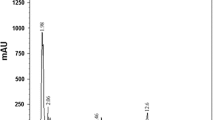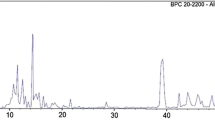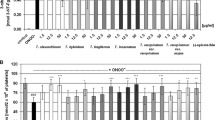Abstract
We evaluated the antioxidant properties of mulberry leaves extract (MLE) and flavonoids isolated from MLE. MLE was prepared by extraction with methanol. Flavonoids were analyzed by high-performance liquid chromatography. Oxidative hemolysis of normal human red blood cells (RBCs) was induced by the aqueous peroxyl radical [2,2′-Azobis (2-amidinopropane) dihydrochloride, AAPH]. MLE contained three flavonoids in the order quercetin (QC) > kaempferol (KF) > astragalin (AG). Oxidative hemolysis of RBCs induced by AAPH was suppressed by MLE, AG, KF, and QC in a time- and dose-dependent manner. MLE and these three flavonoids prevented the depletion of cystosolic antioxidant glutathione (GSH) in RBCs. AG had the greatest protective effect against AAPH-induced oxidative hemolysis and GSH depletion in RBCs.




Similar content being viewed by others
References
Asano, N., T. Yamashita, K. Yasuda, K. Ikeda, H. Kizu, Y. Kameda, A. Kato, R.J. Nash, H.S. Lee, and K.S. Ryu. 2001. Polyhydroxylated alkaloids isolated from mulberry trees (Morus alba L.) and silkworms (Bombyxmori L.). Journal of Agriculture and Food Chemistry 49: 4208–4213.
Asgary, S., G. Naderi, and N. Askari. 2005. Protective effect of flavonoids against red blood cell hemolysis by free radicals. Experimental and Clinical Cardiology 10: 88–90.
Chan, K., H. Ho, C. Peng, K. Lan, M. Lin, H. Chen, and C. Wang. 2010. Polyphenol-rich extract from mulberry leaf inhibits vascular smooth muscle cell proliferation involving upregulation of p53 and inhibition of cyclin-dependent kinase. Journal of Agriculture and Food Chemistry 58: 2536–2542.
Csiszar, A., A. Podlutsky, M.S. Wolin, G. Losonczy, P. Pacher, and Z. Ungvari. 2009. Oxidative stress andaccelerated vascular aging: implications for cigarette smoking. Frontiers in Bioscience 14: 3128–3144.
Dai, F., Q. Miao, B. Zhou, L. Yang, and Z.L. Liu. 2006. Protective effects of flavonols and their glycosides against free radical-induced oxidative hemolysis of red blood cells. Life Sciences 78: 488–2493.
Enkhmaa, B., K. Shiwaku, T. Katsube, K. Kitajima, E. Anuurad, M. Yamasaki, and Y. Yamane. 2005. Mulberry (Morus alba L.) leaves and their major flavonol quercetin 3-(6-malonylglucoside) attenuate atherosclerotic lesion development in LDL receptor-deficient mice. Journal of Nutrition 135: 729–734.
Hseu, Y.C., W.C. Chang, Y.T. Hseu, C.Y. Lee, Y.J. Yech, P.C. Chen, J.Y. Chen, and H.L. Yang. 2007. Protection of oxidative damage by aqueous extract from Antrodiacamphorata mycelia in normal human erythrocytes. Life Sciences 71: 469–482.
Jani, N., J. Ziogas, J.A. Angus, and C.E. Wright. 2012. Exogenous glutathione is essential in the testing of antioxidant capacity using radical-induced haemolysis. Journal of Pharmacological and Toxicological Methods 65: 142–146.
Jones, D.P. 2008. Radical-free biology of oxidative stress. American Journal of Physiology. Cell Physiology. 295: 849–868.
Kaefer, C.M., and J.A. Milner. 2008. The role of herbs and spices in cancer prevention. Journal of Nutritional Biochemistry 19: 347–361.
Katsube, T., N. Imawaka, Y. Kawano, Y. Yamazaki, K. Shiwaku, and Y. Yamane. 2006. Antioxidant flavonol glycosides in mulberry (Morus alba L.) leaves isolated based on LDL antioxidant activity. Food Chemistry 97: 25–31.
Katsube, T., M. Yamasaki, K. Shiwaku, T. Ishijima, I. Matsumoto, K. Abe, and Y. Yamasaki. 2010. Effect of flavonol glycoside in mulberry (Morus alba L.) leaf on glucose metabolism and oxidative stress in liver in diet-induced obese mice. Journal of the Science of Food and Agriculture 90: 2386–2392.
Khan, M.A., A.A. Rahman, S. Islam, P. Khandokhar, S. Parvin, M.B. Islam, M. Hossain, M. Rashid, G. Sadik, S. Nasrin, M.N. Mollah, and A. Alam. 2013. A comparative study on the antioxidant activity of methanolic extracts from different parts of Morus alba L (Moraceae). BMC Research Notes 6: 24.
Kim, G.N., and H.D. Jang. 2011. Flavonol content in the water extract of the mulberry (Morus alba L.) leaf and their antioxidant capacities. Journal of Food Science 76: 869–873.
Kotani, M., M. Matsumoto, A. Fujita, S. Higa, W. Wang, M. Suemura, T. Kishimoto, and T. Tanaka. 2000. Persimmon leaf extract and astragalin inhibit development of dermatitis and IgE elevation in NC/Nga mice. The Journal of Allergy and Clinical Immunology 106: 159–166.
Loeser, R.F. 2011. Aging and Osteoarthritis. Current Opinion in Rheumatology 23: 492–496.
Luangaram, S., U. Kukongviriyapan, P. Pakdeechote, V. Kukongviriyapan, and P. Pannangpetch. 2007. Protective effects of quercetin against phenyl hydrazine-induced vascular dysfunction and oxidative stress in rats. Food and Chemical Toxicology 45: 448–455.
Maritim, A.C., and R.A. Sanders. 2003. Diabetes, oxidative stress, and antioxidants: a review. Journal of Biochemical and Molecular Toxicology 17: 24–38.
Matsumoto, M., M. Kotani, A. Fujita, S. Higa, T. Kishimoto, M. Suemura, and T. Tanaka. 2002. Oral administration of persimmon leaf extract ameliorates skin symptoms and transepidermal water loss in atopic dermatitis model mice, NC/Nga. The British Journal of Dermatology 146: 221–227.
Paiva-Martins, F., J. Fernandes, S. Rocha, H. Nascimento, R. Vitorino, F. Amado, F. Borges, L. Belo, and A. Santos-Silva. 2009. Effects of olive oil polyphenols on erythrocyte oxidative damage. Molecular Nutrition & Food Research 53: 609–616.
Peng, L., Y. YaLing, P. GuoPin, Z. FanRong, and W. QianQian. 2011. Effect of astragalin on paraoxon– induced vascular endothelium dysfunction. The Journal Board of Plant Diseases and Pests 2: 73–76.
Ray, P.D., B.W. Huang, and Y. Tsuji. 2012. Reactive oxygen species (ROS) homeostasis and redox regulationincellular signaling. Cellular Signalling 24: 981–990.
Rizzo, A.M., P.A. Corsetto, G. Montorfano, S. Milani, S. Zava, S. Tavella, R. Cancedda, and B. Berra. 2012. Effects of long-term space flight on erythrocytes and oxidative stress of rodents. PLoS ONE 7: e32361.
Sharma, A., P.N. Bernatchez, and J.B. de Haan. 2012. Targeting endothelial dysfunction in vascular complications associated with diabetes. International Journal of Vascular Medicine. doi:10.1155/2012/750126.
Stevenson, D.E., and R.D. Hurst. 2007. Polyphenolic phytochemicals-just antioxidants or much more? Cellular and Molecular Life Sciences 64: 2900–2916.
Tang, W.H., K.A. Martin, and J. Hwa. 2012. Aldose reductase, oxidative stress, and diabetic mellitus. Frontiers in Pharmacology 3: 87.
Wang, K.J., C.R. Yang, and Y. Zhang. 2007. Phenolic antioxidants from Chinese toon (fresh young leaves and shoots of Toona sinensis). Food Chemistry 101: 365–371.
Xiao, Z.P., H.K. Wu, T. Wu, H. Shi, B. Hang, and H.A. Aisa. 2006. Kaempferol and quercetin flavonoids from Rosa rugosa. Chemistry of Natural Compounds 42(7): 36–737.
Zhishen, J., T. Mengcheng, and W. Jianming. 1999. The determination of flavonoid contents in mulberry and their scavenging effects on superoxide radicals. Food Chemistry 64: 555–559.
Zou, C.G., N.S. Agar, and G.L. Jones. 2001. Oxidative insult to human red blood cells induced by free radical initiator AAPH and its inhibition by a commercial antioxidant mixture. Life Sciences 169: 75–86.
Acknowledgments
This work was carried out with the support of “Cooperative Research Program for Agriculture Science & Technology Development (Project No. 00966303)” Rural Development Administration, Republic of Korea.
Author information
Authors and Affiliations
Corresponding author
Electronic supplementary material
Below is the link to the electronic supplementary material.
Rights and permissions
About this article
Cite this article
Choi, J., Kang, H.J., Kim, S.Z. et al. Antioxidant effect of astragalin isolated from the leaves of Morus alba L. against free radical-induced oxidative hemolysis of human red blood cells. Arch. Pharm. Res. 36, 912–917 (2013). https://doi.org/10.1007/s12272-013-0090-x
Received:
Revised:
Accepted:
Published:
Issue Date:
DOI: https://doi.org/10.1007/s12272-013-0090-x




